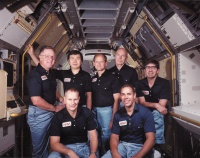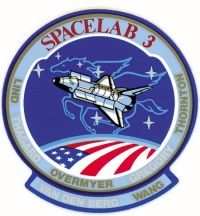STS-51B
From The Space Library
 | |
| Organization | NASA-OfficeofSpaceScienceApplications(UnitedStates),NASA-Office of Space Flight (United States) |
|---|---|
| Mission type | Earth Science,Human Crew,Life Science,Microgravity,Planetary Science,Solar Physics,Space Physics |
| Launch date | April 29, 1985 |
| Launch vehicle | Space Shuttle |
| Launch site | Cape Canaveral, United States |
| COSPAR ID | 1985-034A |
| Experiments | Here |
| Alternate Names | STS 17,Spacelab 3,15665 |
| Additional Information | Here |
| Data Collection | Here |
| Payload Mass Up | 14500.0 kg |
The first dedicated mission with acquisition of science data as its primary objective, Spacelab 3 was a multidisciplinary mission emphasizing investigations requiring the low-gravity environment of Earth orbit. The experiments covered several disciplines. For the materials processing discipline, higher-quality crystals were grown by two methods; namely, seed crystal growth in a saturated solution and condensation from the vapor phase. The two fluid physics experiments studied the dynamic behavior of rotating and oscillating liquid drops, and the convection processes found in planetary atmospheres and in stellar interiors. The performance of equipment and facilities specially designed for investigations on the Spacelab Life Sciences mission series was evaluated. The investigations selected for the Spacelab 3 mission originated in the United States, France, and India, and represented a total of five different disciplines, including material science, life sciences, fluid mechanics, atmospheric science, and astronomy. Two of the investigations, one in material science and one in astronomy, had already flown aboard Spacelab 1. Many of the Spacelab 3 investigations were scheduled to be modified and reflown on later missions to further explore the discoveries of this mission. Some of the experiments were located in the module, some on the pallet in the payload bay, and one at middeck. Spacelab 3 consisted of a Spacelab long module and a pallet. The mission successfully demonstrated the capability of Spacelab for multidiscipline research in microgravity.
Mission patch:

